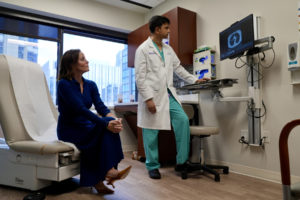New Study Shows Lung Cancer Surveillance in the United States Misses Most Patients; Northwestern Medicine Investigators Urge Universal Age-based Screening – Northwestern University

Report on Expanded Low-Dose CT Screening and its Alignment with Sustainable Development Goals
A recent initiative by Northwestern Medicine to launch a comprehensive Lung Health Center highlights a critical effort to advance public health outcomes, directly supporting several United Nations Sustainable Development Goals (SDGs). The center’s mission to expand low-dose CT screenings beyond restrictive guidelines addresses significant gaps in healthcare equity and disease prevention.
Analysis of Screening Deficiencies and Impact on SDGs
A study published in JAMA Network Open involving nearly 1,000 lung cancer patients at Northwestern Medicine revealed systemic failures in current screening protocols, undermining progress toward key global health targets.
- SDG 3 (Good Health and Well-being): Current U.S. Preventive Services Task Force (USPSTF) criteria, which are limited to adults aged 50-80 with a significant smoking history, would have failed to identify 65 percent of the lung cancer patients studied. This gap significantly impedes the goal of reducing premature mortality from non-communicable diseases.
- SDG 5 (Gender Equality): The study found that the two-thirds of patients excluded by the guidelines were disproportionately women, indicating a critical gender-based disparity in access to life-saving preventive care.
- SDG 10 (Reduced Inequalities): The narrow focus on smoking history creates health inequities by excluding never-smokers and other vulnerable populations who also develop lung cancer, thereby limiting access to early diagnosis and treatment.
Proposed Framework for Universal Screening to Achieve Global Goals
Investigators recommend a revised approach to align with the principles of universal health coverage and proactive disease management as outlined in the SDGs.
- Implement Universal Age-Based Screening: The report advocates for expanding screening to all individuals aged 40-85, a strategy that would mirror successful universal screening programs for breast and colon cancer.
- Enhance Early Detection: This expanded framework is estimated to detect 94 percent of lung cancers, a significant improvement that would contribute directly to SDG Target 3.4 (reduce by one-third premature mortality from non-communicable diseases).
- Prevent Premature Deaths: The proposed universal screening is projected to prevent more than 26,000 additional deaths annually in the United States, demonstrating a cost-effective and high-impact public health intervention.
The Lung Health Center: An Innovative Model for Integrated Healthcare
The newly launched Lung Health Center at the Canning Thoracic Institute serves as an innovative model for achieving integrated and equitable healthcare, reflecting the aims of SDG 9 (Industry, Innovation, and Infrastructure).
Center Objectives and Strategic Alignment
- Comprehensive Health Assessment: A single low-dose CT scan provides a holistic view of chest health, enabling early detection of multiple conditions simultaneously. This innovative approach maximizes diagnostic efficiency and patient benefit.
- Multi-Condition Screening: The scans will be evaluated for early signs of pulmonary fibrosis, post-COVID lung damage, cardiovascular disease (coronary calcium), and osteoporosis. This integrated strategy supports a comprehensive approach to well-being (SDG 3).
- Research and Guideline Development: The center will study screening results to generate evidence aimed at reforming national guidelines, fostering scientific innovation to improve public health infrastructure.
Addressing Broader Health Determinants and Vulnerable Populations
The initiative actively seeks to reduce health inequalities (SDG 10) by extending screening eligibility to populations affected by a range of health and environmental determinants.
Expanded Target Groups for Screening
- COVID-19 survivors with persistent respiratory issues.
- Individuals exposed to environmental pollutants such as wildfire smoke and industrial pollution, linking public health to environmental concerns (SDG 11).
- Persons with a family history of lung disease.
- Individuals exposed to secondhand smoke, vaping, or marijuana use.
- Demographic groups at elevated risk, including Asian women, thereby promoting gender and racial equity in healthcare (SDG 5, SDG 10).
By providing a baseline chest health assessment for a broader population, this model allows for the early diagnosis of interstitial lung disease, pulmonary fibrosis, and lung cancer years before they would otherwise be detected, fundamentally advancing the goal of good health and well-being for all.
Analysis of Sustainable Development Goals in the Article
1. Which SDGs are addressed or connected to the issues highlighted in the article?
The article addresses several Sustainable Development Goals (SDGs) through its focus on improving healthcare outcomes, addressing inequities in medical screening, and leveraging technology and research for public health.
- SDG 3: Good Health and Well-being: This is the most prominent SDG in the article. The entire initiative of the Lung Health Center is aimed at ensuring healthy lives and promoting well-being by improving the early detection of life-threatening non-communicable diseases like lung cancer, cardiovascular disease, and osteoporosis. The article’s core message is about reducing premature mortality through better preventive care.
- SDG 5: Gender Equality: The article explicitly mentions that the current restrictive screening guidelines disproportionately exclude women from lung cancer screening. By advocating for universal age-based screening, the initiative aims to correct this imbalance and ensure women have equal access to life-saving preventive healthcare, directly addressing gender-based inequities in health outcomes.
- SDG 10: Reduced Inequalities: This goal is addressed by the call to expand screening criteria beyond the narrow definition of smokers. The article highlights that current guidelines exclude two-thirds of patients, including never-smokers and other at-risk demographics. The proposed universal screening model is designed to reduce these health inequalities by providing more equitable access to early diagnosis for all individuals within a specific age range, regardless of their smoking history or other status.
- SDG 9: Industry, Innovation, and Infrastructure: The article discusses the launch of a comprehensive Lung Health Center, which represents an investment in health infrastructure. Furthermore, it emphasizes the use of low-dose CT screening technology and the center’s role in conducting research (“studies to evaluate low-dose CT screening”) and publishing findings to “inform changes to existing guidelines.” This commitment to scientific research and technological application to solve a public health problem aligns with the goal of fostering innovation.
2. What specific targets under those SDGs can be identified based on the article’s content?
Based on the issues and solutions presented, several specific SDG targets can be identified:
-
Target 3.4: By 2030, reduce by one-third premature mortality from non-communicable diseases through prevention and treatment and promote mental health and well-being.
- The article directly supports this target by focusing on the early detection and prevention of major non-communicable diseases. It states that lung cancer is America’s deadliest cancer and that the proposed screening could prevent “more than 26,000 extra deaths annually.” The screening also detects cardiovascular disease and osteoporosis, further contributing to the reduction of premature mortality from NCDs.
-
Target 5.1: End all forms of discrimination against all women and girls everywhere.
- The article identifies a systemic issue where current screening guidelines are discriminatory in effect, as “two-thirds of patients who would have been excluded were disproportionately women.” The proposed universal screening aims to eliminate this discriminatory practice in healthcare access, ensuring women are not unfairly excluded from vital preventive care.
-
Target 10.3: Ensure equal opportunity and reduce inequalities of outcome, including by eliminating discriminatory laws, policies and practices and promoting appropriate legislation, policies and action in this regard.
- The core argument of the article is to change a discriminatory policy—the U.S. Preventive Services Task Force (USPSTF) screening criteria. By advocating for universal age-based screening, Northwestern Medicine is promoting a new policy that would ensure more equal opportunities for early cancer detection and thereby reduce inequalities in health outcomes for groups like never-smokers and women.
-
Target 9.5: Enhance scientific research, upgrade the technological capabilities of industrial sectors in all countries…including…encouraging innovation and substantially increasing…research and development…
- The establishment of the Lung Health Center to “conduct studies,” “evaluate low-dose CT screening,” and publish results “to inform changes to existing guidelines” is a direct example of enhancing scientific research and innovation. The initiative uses advanced technology (low-dose CT) and a research-driven approach to improve public health policy and practice.
3. Are there any indicators mentioned or implied in the article that can be used to measure progress towards the identified targets?
Yes, the article mentions and implies several quantitative and qualitative indicators that can be used to measure progress:
-
Indicator for Target 3.4 (Mortality Reduction):
- Number of preventable deaths: The article explicitly estimates that the expanded screening could prevent “more than 26,000 extra deaths annually.” This provides a clear metric for measuring the impact on mortality rates.
- Cancer detection stage: The article notes that “nearly 80 percent of cases aren’t discovered until they’ve reached advanced stages.” An indicator of progress would be a significant decrease in this percentage, reflecting an increase in early-stage detection.
-
Indicator for Targets 5.1 and 10.3 (Inequality Reduction):
- Screening eligibility rates by demographic: The article states that under current criteria, “only 35 percent” of lung cancer patients would have qualified for screening, with women and never-smokers being disproportionately excluded. A key indicator would be the percentage of diagnosed patients who would have been eligible under the new universal guidelines, with the goal of reaching the estimated “94 percent” for all demographics, including women.
-
Indicator for Target 9.5 (Research and Innovation):
- Volume of research output: The article mentions that the center will “conduct studies” and that “results of these screenings will be studied and published.” An indicator of progress would be the number of studies and publications produced by the center that contribute to the evidence base for changing screening guidelines.
Summary of Findings
| SDGs | Targets | Indicators |
|---|---|---|
| SDG 3: Good Health and Well-being | 3.4: Reduce by one-third premature mortality from non-communicable diseases through prevention and treatment. |
|
| SDG 5: Gender Equality | 5.1: End all forms of discrimination against all women and girls everywhere. |
|
| SDG 10: Reduced Inequalities | 10.3: Ensure equal opportunity and reduce inequalities of outcome by eliminating discriminatory policies. |
|
| SDG 9: Industry, Innovation, and Infrastructure | 9.5: Enhance scientific research and encourage innovation. |
|
Source: news.feinberg.northwestern.edu
What is Your Reaction?
 Like
0
Like
0
 Dislike
0
Dislike
0
 Love
0
Love
0
 Funny
0
Funny
0
 Angry
0
Angry
0
 Sad
0
Sad
0
 Wow
0
Wow
0




















































.jpg.webp?itok=0ZsAnae9#)














:focal(1500,1000)/https://media.globalcitizen.org/a6/9a/a69a4720-d8a1-4715-b596-18738d03c05c/rotary_polio_hero_image.jpg?#)










